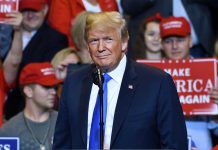
China’s diplomatic maneuvers post-Trump show a delicate balancing act between cooperative veneers and deep-seated national agendas.
At a Glance
- A proposed U.S. grand strategy suggests reinforcing cooperative security to counter China’s expansion.
- China’s global ambitions are being driven by initiatives like One Belt, One Road.
- In response to U.S. restrictions, China is emphasizing economic and technological independence.
- Regional tensions continue, particularly around Taiwan and the South China Sea.
China’s Strategic Posture with the U.S.
U.S.-China relations have grown more contentious as China has shifted focus to economic and technological independence since Trump’s election. Despite initial overtures to work with the U.S., China has pursued a broader strategy to assert itself globally, especially in the Global South. While Xi Jinping initially showed some willingness to cooperate, he quickly moved to more assertive posturing. This change in tone reflects China’s desire for economic self-sufficiency amid a fierce technological rivalry with the U.S. and its allies.
Economic security remains a significant source of friction as China pushes back against U.S.-imposed restrictions. The U.S. finds itself in need of fresh strategies to counter China’s growing influence effectively. By leveraging the One Belt, One Road initiative, China continues to expand its reach across Asia, Africa, and Europe, effectively sidestepping many of the constraints America has tried to impose. This economic and political integration strategy has allowed China to deepen its ties globally, making it harder for the U.S. to counterbalance China’s growing economic footprint.
U.S. Tactical Responses
In response, American strategists are advocating for a cooperative security approach, merging national power and diplomacy to maintain regional stability. Conservative analysts emphasize the need for a strong American presence in multilateral institutions, such as ASEAN, to counterbalance China’s rise on the world stage. Financial support and diplomatic engagement in Asia are crucial to creating economic interdependence that limits China’s influence. Grand bargaining—strategic concessions combined with clear expectations—may offer diplomatic pathways to manage regional conflicts while preserving the U.S.’s economic and political dominance.
The U.S. should strengthen its traditional alliances and lead within international institutions to regulate China’s ambitions. Areas like nuclear nonproliferation present avenues for limited cooperation, particularly concerning North Korea, while the U.S. can continue to promote freedom and transparency through forums like the UN. These strategies underscore the importance of maintaining strong, value-driven alliances that can both deter China and support a stable global order.
Regional Flashpoints and Xi’s Tactical Moves
China’s assertiveness over Taiwan and in the South China Sea presents serious security concerns for the U.S. and its allies. Xi Jinping’s pursuit of Taiwan’s reunification under the banner of China’s “national rejuvenation” has raised tensions to a new level. His territorial claims create conflicts with neighboring countries like the Philippines, putting U.S. allies on edge. Any potential for military action in these regions requires vigilance and strong American support for allies to avoid the risk of regional destabilization.
China’s foreign policy reveals a complex balancing act—promoting cooperation while staunchly defending its national sovereignty. This approach underscores the broader challenges the U.S. and other nations face in a multipolar world, where engaging globally requires an unyielding commitment to preserving national interests. As America continues to adapt its strategies, balancing diplomatic, military, and economic tools will be key to countering China’s ambitions and ensuring a stable, free, and prosperous world order.














